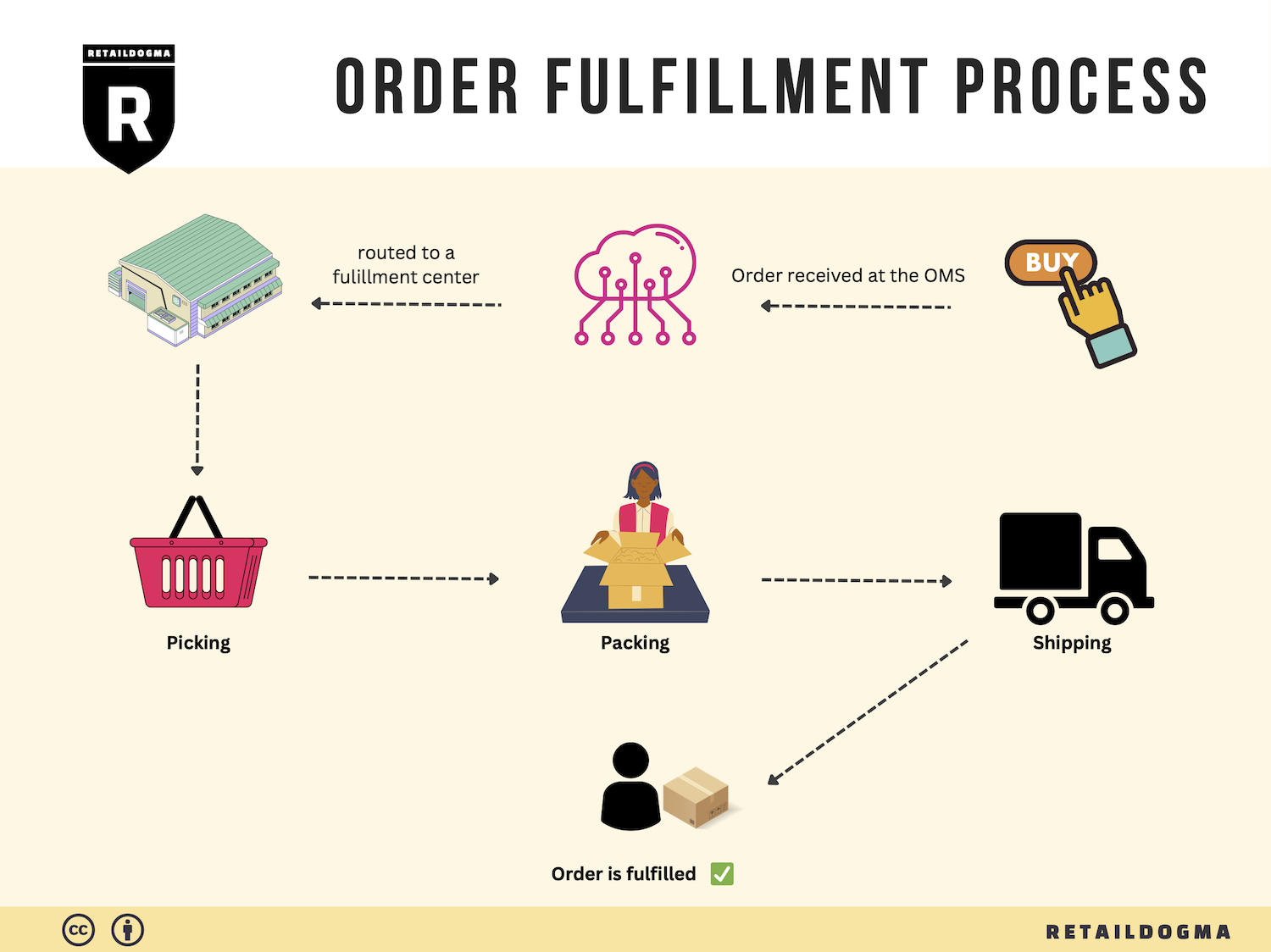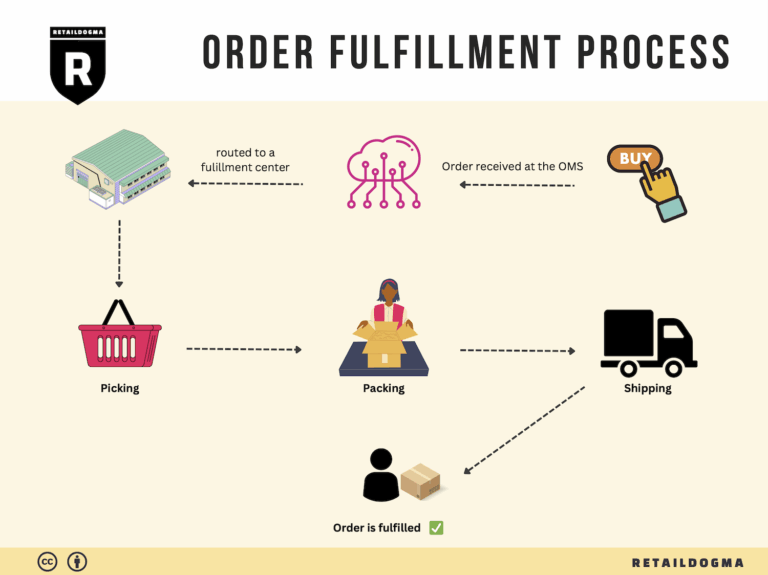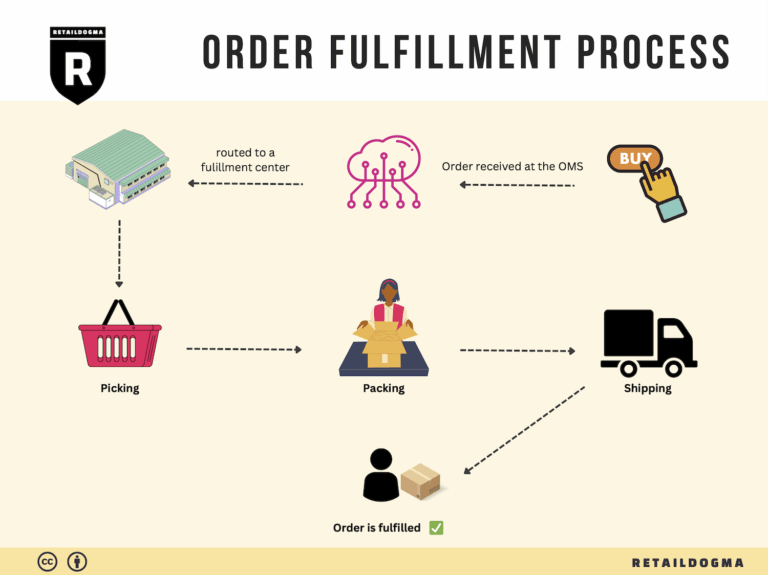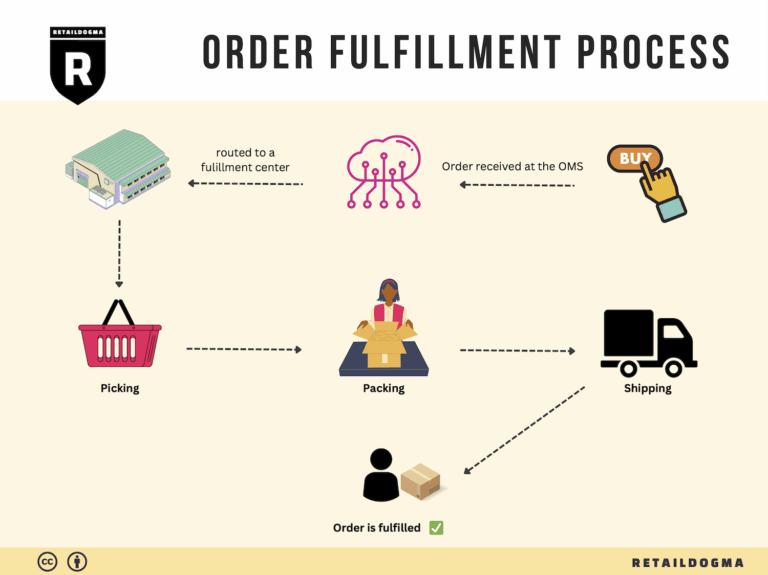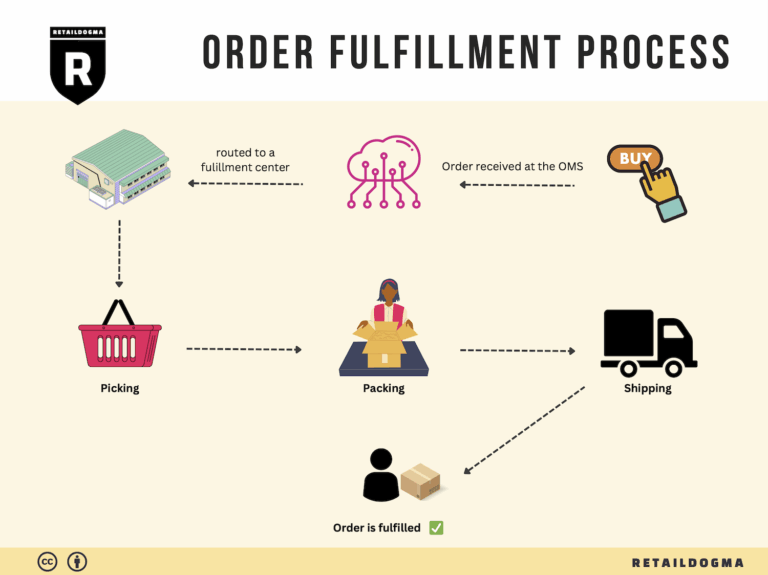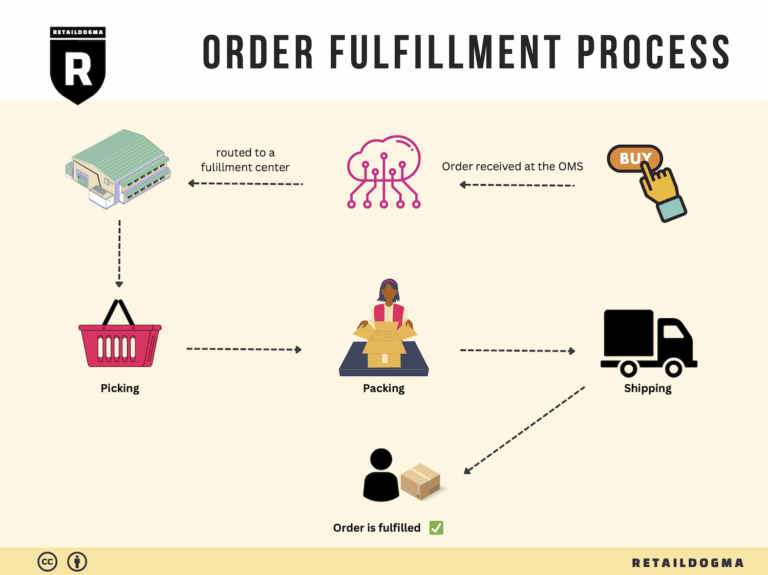What Is A Fulfillment Center? A Complete Guide (2025)
What is E-commerce Fulfillment? An Introduction for Growing Businesses
Understanding the Fulfillment Process
As your e-commerce business begins to grow, you may find yourself facing a common challenge: the overwhelming tasks of packing and shipping orders. Managing these logistics can quickly become a bottleneck, diverting your focus from strategic growth initiatives and customer engagement. This is where understanding e-commerce fulfillment becomes crucial.
Fulfillment is simply the process of getting a product from your warehouse or supplier to your customer’s doorstep. It encompasses everything from inventory management to order processing and shipping. As businesses scale, the complexity of fulfillment often increases, making it essential to adopt efficient systems and partnerships.
Key Components of E-commerce Fulfillment
In this guide, we will explore various fulfillment models that can help streamline your operations. You may have heard of Third-Party Logistics (3PL) providers, which manage logistics on behalf of your business, or Fulfillment by Amazon (FBA), where Amazon takes care of storage, packaging, and shipping for you. Understanding these models is vital for making informed decisions that align with your business goals.
We’ll also cover the core services involved in fulfillment, including:
- Inventory Management: Keeping track of stock levels to avoid overstocking or stockouts.
- Order Processing: The steps taken from when a customer places an order to when it is shipped.
- Shipping: Choosing the right carriers and methods to ensure timely delivery.
Choosing the Right Fulfillment Partner
Selecting a fulfillment partner is one of the most critical decisions you will make as you scale. Factors to consider include their reliability, technology capabilities, and alignment with your business values. We will provide guidance on how to evaluate potential partners and what questions to ask to ensure they meet your needs.
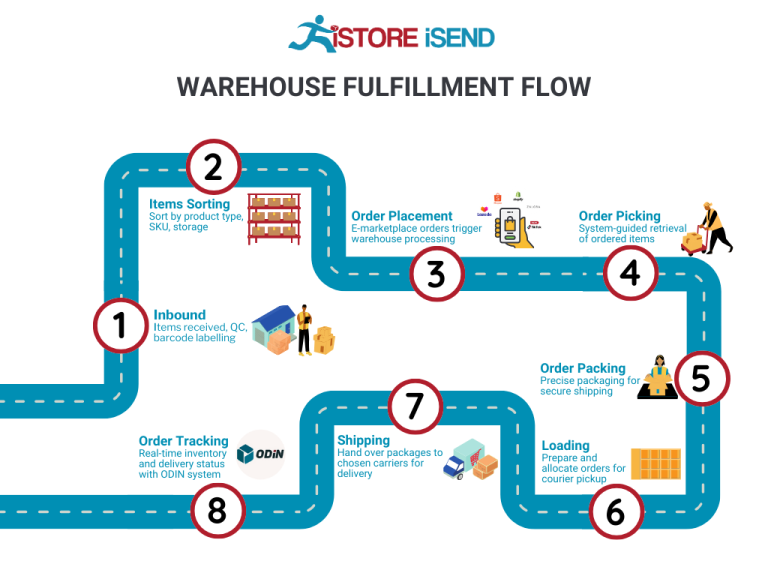
Understanding Pricing Models
Finally, we will delve into the various pricing structures associated with fulfillment services. Understanding these costs can help you budget effectively and avoid unexpected fees that could impact your profitability.
Goal of the Guide
The ultimate goal of this guide is to empower you as a business owner or operations manager to make smart, informed decisions about your logistics. By understanding the intricacies of e-commerce fulfillment, you can enhance your operational efficiency, improve customer satisfaction, and focus on driving your business forward. Whether you choose to manage fulfillment in-house or partner with a logistics provider, the insights presented here will help you navigate the complexities of scaling your e-commerce business.
What You’ll Learn In This Guide
- What is E-commerce Fulfillment? An Introduction for Growing Businesses
- The Order Fulfillment Process: From ‘Buy’ Button to Customer’s Door
- Comparing Fulfillment Models: In-House vs. 3PL vs. Dropshipping
- A Deep Dive into Amazon FBA: Pros, Cons, and Who It’s For
- Core Services Offered by Fulfillment Centers
- How to Choose a Fulfillment Partner: A 6-Point Checklist
- Understanding Fulfillment Pricing: A Breakdown of Common Fees
- Frequently Asked Questions (FAQs) about Fulfillment
- Conclusion: Is Outsourcing Fulfillment the Right Move for Your Business?
- Important Disclaimer
The Order Fulfillment Process: From ‘Buy’ Button to Customer’s Door
1. Receiving Inventory
The order fulfillment process begins with receiving inventory at the fulfillment center. When products arrive, they are checked against the purchase orders to ensure accuracy, quality, and quantity. This step is crucial as it establishes a reliable inventory base for subsequent steps. Key terms associated with this stage include SKU (Stock Keeping Unit), which uniquely identifies each product and helps in tracking inventory levels.
Efficient receiving processes minimize errors and delays, ultimately leading to improved customer satisfaction. It is advisable for e-commerce businesses to implement robust receiving protocols, including barcode scanning and quality checks, to streamline this phase. Accurate receiving sets the tone for the entire fulfillment process, as discrepancies here can lead to inventory shortages or overages, impacting sales and customer trust.
2. Warehouse Storage
Once the inventory is received and verified, products are moved to their designated locations within the warehouse storage area. This step involves organizing items in a manner that optimizes space and facilitates easy access for order fulfillment. Businesses often utilize various storage strategies, such as ABC analysis, which categorizes products based on their sales volume, or slotting, which places fast-moving items in easily accessible locations.
Proper warehouse storage is essential for efficiency and accuracy. An organized storage system reduces the time spent locating items during the picking process, which directly impacts order processing speed. Implementing warehouse management systems (WMS) can further enhance storage efficiency by automating inventory tracking and location management.
3. Order Picking
The next step is order picking, where items are selected from their storage locations based on customer orders. This process can be executed using various picking methods, such as single order picking, batch picking, or zone picking, depending on the order volume and complexity.
Order picking is critical because it directly affects order accuracy and fulfillment speed. Utilizing tools like pick lists—which outline the items to be collected for each order—can significantly enhance the efficiency of this process. Additionally, integrating technology such as handheld scanners or mobile picking solutions can help reduce errors and improve productivity. Businesses should regularly assess their picking strategies to find the most effective method that aligns with their order profiles.
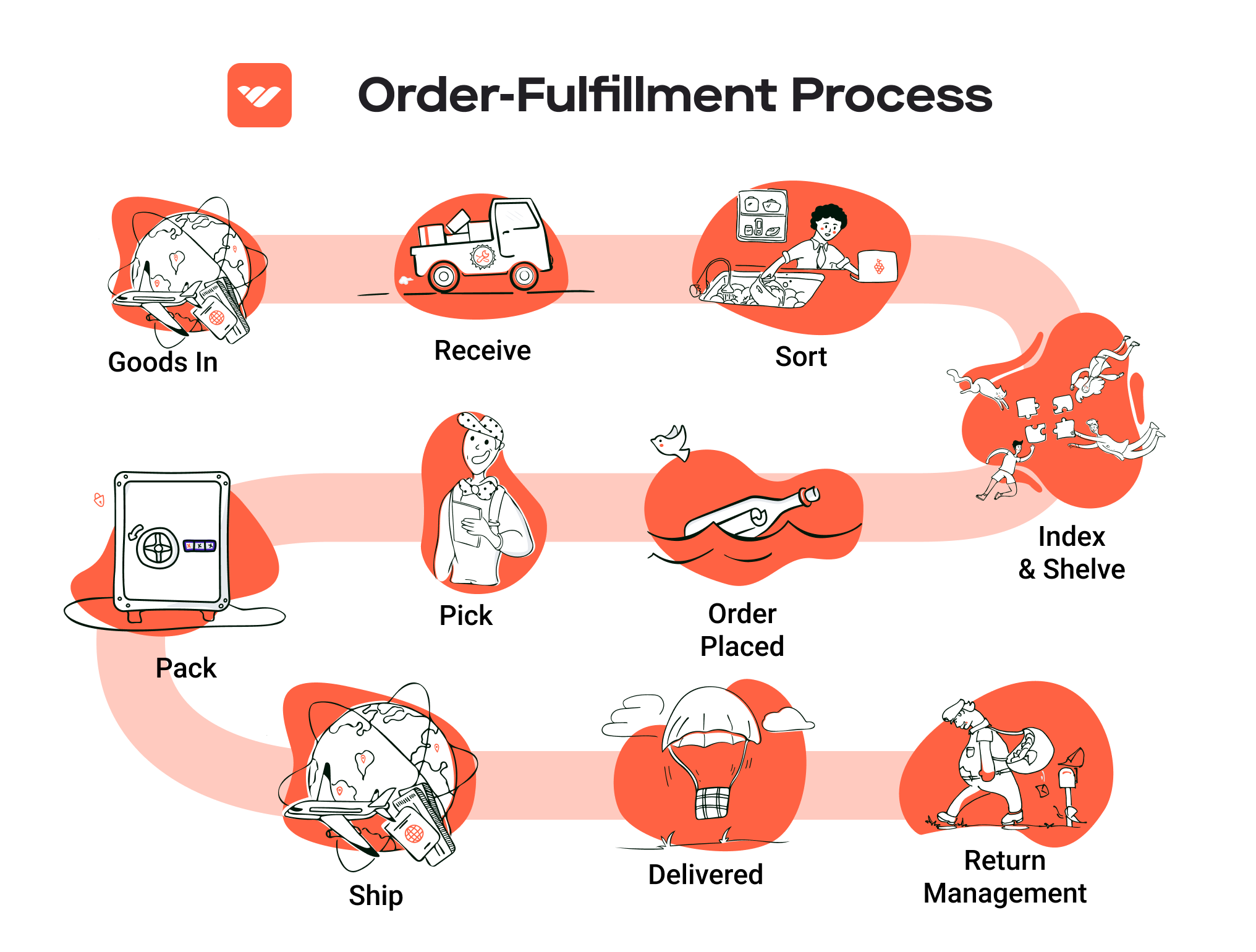
4. Order Packing
Once the items are picked, they move to the order packing stage. Here, products are securely packaged to prevent damage during transit. This step involves selecting appropriate packaging materials, labeling packages, and sometimes including promotional materials or invoices.
Packing is vital not only for protecting the items but also for providing a positive unboxing experience for customers. Using packing slips and ensuring that packages are labeled correctly with tracking information are key components of this phase. Businesses can benefit from investing in automated packing systems that optimize material usage and speed up the packing process. A well-executed packing process enhances customer satisfaction and can lead to repeat business.
5. Shipping & Delivery
The final step in the order fulfillment process is shipping and delivery. Once packed, orders are handed over to shipping carriers for delivery to the customer’s address. This stage includes selecting the most cost-effective and timely shipping options and generating tracking information that is communicated to the customer.
Shipping and delivery are critical to customer satisfaction and retention. Businesses should establish strong relationships with various shipping providers to negotiate rates and improve service levels. Key terms in this step include last mile delivery, which refers to the final leg of the shipping journey, often the most challenging and costly part of the logistics process.
Effective shipping strategies can significantly impact a company’s bottom line. Offering multiple shipping options, including expedited delivery, can cater to different customer needs and enhance the overall shopping experience. By continuously analyzing shipping performance and customer feedback, e-commerce businesses can refine their logistics strategies for better outcomes.
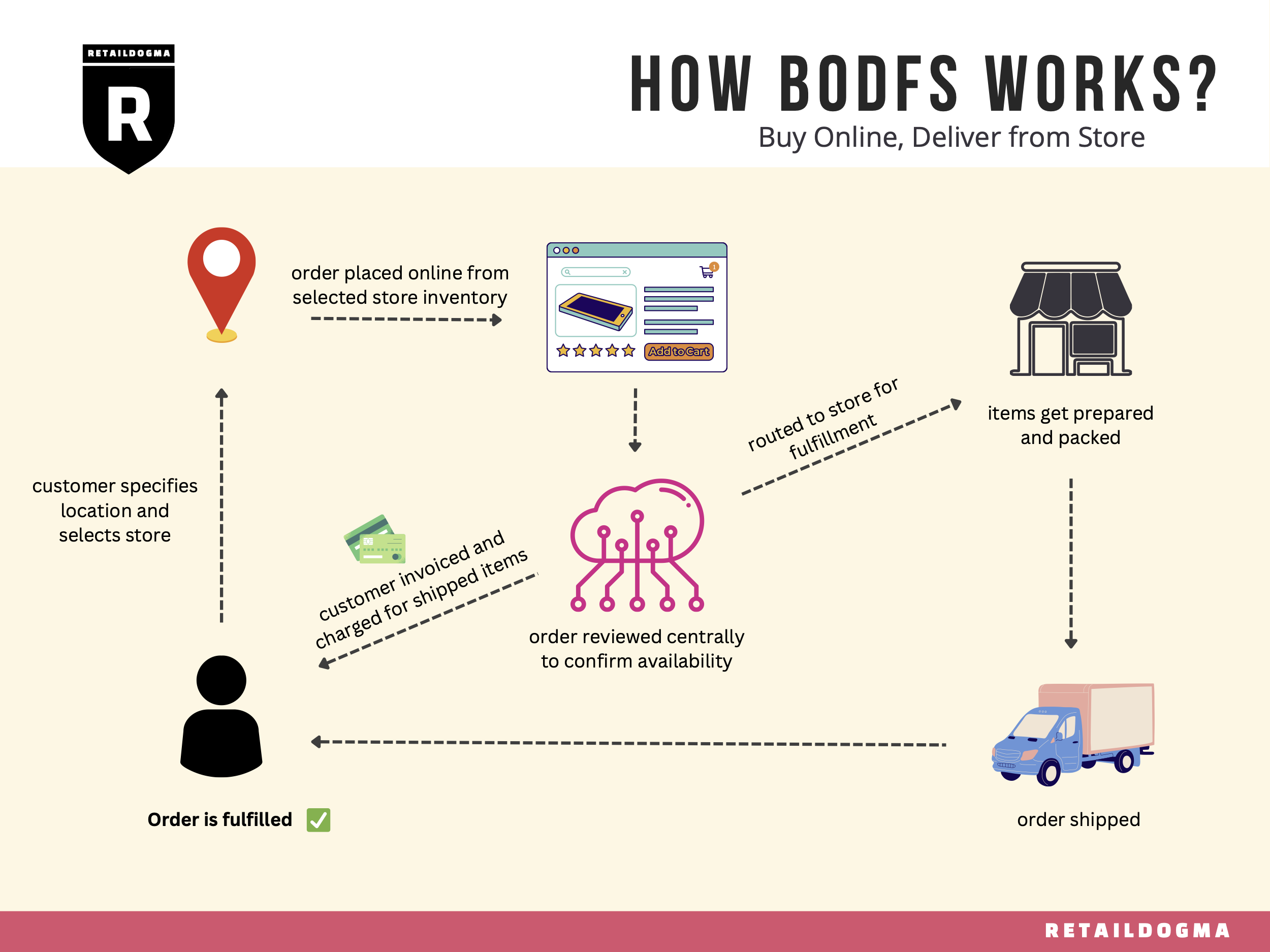
By understanding and optimizing each step of the order fulfillment process—from receiving inventory to shipping and delivery—e-commerce businesses can scale their operations effectively while maintaining high levels of customer satisfaction.
Comparing Fulfillment Models: In-House vs. 3PL vs. Dropshipping
Fulfillment Model Comparison Table
| Model | Who Handles Inventory | Best For (Business Stage) | Key Advantage | Key Disadvantage |
|---|---|---|---|---|
| In-House Fulfillment | Business itself | Startups to established businesses | Full control over inventory and fulfillment process | High operational costs and resource-intensive |
| Third-Party Logistics (3PL) | Third-party provider | Growth-stage businesses | Scalability and reduced overhead costs | Less control over inventory and fulfillment speed |
| Dropshipping | Supplier or manufacturer | New businesses or niche markets | Low upfront investment and no inventory management | Lower profit margins and reliance on supplier reliability |
In-House Fulfillment
In-house fulfillment involves managing the entire inventory and order fulfillment process within your own business. This model is often favored by startups and established businesses that want complete control over their inventory, shipping, and customer service. By handling everything internally, businesses can ensure that their branding and customer experience are consistent and tailored to their specific needs. However, this model comes with significant operational costs, including warehousing, staffing, and technology investments. Additionally, as the business scales, maintaining efficient operations can become resource-intensive, leading to potential bottlenecks and increased complexity. Entrepreneurs must weigh the benefits of control against the financial and logistical demands of running an in-house fulfillment operation.
Third-Party Logistics (3PL)
Third-party logistics (3PL) providers offer a flexible solution for businesses looking to scale their operations without the burden of managing logistics themselves. In this model, a third-party provider handles storage, inventory management, and shipping, allowing businesses to focus on core activities like marketing and sales. This is particularly beneficial for growth-stage companies that need to adapt quickly to changing market demands. The key advantage of using a 3PL is scalability; businesses can easily adjust their logistics needs based on sales fluctuations without investing heavily in infrastructure. However, the trade-off is a reduced level of control over inventory and fulfillment processes, which can impact delivery speed and customer satisfaction if not managed properly. Businesses must carefully select reliable 3PL partners to ensure alignment with their operational goals and customer expectations.
Dropshipping
Dropshipping is a fulfillment model where the retailer does not keep products in stock. Instead, when a customer places an order, the retailer purchases the item from a third-party supplier who ships it directly to the customer. This model is particularly attractive for new businesses or those in niche markets, as it requires minimal upfront investment and eliminates the need for inventory management. Entrepreneurs can test new products without the financial risk associated with purchasing inventory upfront. However, dropshipping comes with notable disadvantages, including lower profit margins due to reliance on suppliers and potential delays in shipping, which can lead to customer dissatisfaction. Additionally, businesses are dependent on their suppliers for product quality and availability, making it crucial to establish strong relationships with reliable partners to ensure a positive customer experience.
Conclusion
Selecting the right fulfillment model is a critical decision for e-commerce businesses looking to scale. Each model—In-house fulfillment, 3PL, and dropshipping—offers distinct advantages and disadvantages that should align with your business goals, operational capabilities, and market demands. By carefully evaluating these factors, e-commerce entrepreneurs can choose a fulfillment strategy that not only meets their current needs but also supports sustainable growth in the future.
A Deep Dive into Amazon FBA: Pros, Cons, and Who It’s For
Understanding Fulfillment by Amazon (FBA)
Fulfillment by Amazon (FBA) is a service provided by Amazon that allows e-commerce sellers to store their products in Amazon’s fulfillment centers. Amazon then takes care of storage, packaging, and shipping of the products to customers. This service enables sellers to leverage Amazon’s extensive logistics network, providing them with a competitive edge in the crowded e-commerce landscape.
How FBA Works
-
Setup: Sellers create an Amazon seller account and enroll in the FBA program. They list their products on Amazon and select which items they want to fulfill through FBA.
-
Shipping Inventory: Sellers send their products to one or more of Amazon’s fulfillment centers. Amazon provides guidelines on how to prepare and package these products to ensure they arrive safely.
-
Storage and Management: Once the products are received, Amazon takes care of storing them in their warehouses. Sellers can monitor their inventory levels through their seller dashboard.
-
Order Fulfillment: When a customer orders a product, Amazon picks, packs, and ships the item on behalf of the seller. They also handle customer service and returns for those orders.
-
Payment: After the sale is made, Amazon deducts its fees and transfers the remaining funds to the seller’s account.
Pros of Using FBA
1. Prime Eligibility
One of the most significant advantages of FBA is that products fulfilled by Amazon are eligible for Amazon Prime. This status can dramatically increase sales, as Prime members tend to prefer Prime-eligible products for the faster shipping options.
2. Customer Trust
Amazon has built a strong reputation for reliability and customer service. By using FBA, sellers can benefit from this trust. Customers are more likely to purchase items that are fulfilled by Amazon, knowing they will receive their orders quickly and that returns will be handled efficiently.
3. Multi-Channel Fulfillment
FBA isn’t limited to Amazon sales. Sellers can use FBA to fulfill orders from other sales channels, such as their own websites or other marketplaces. This flexibility allows businesses to streamline their logistics and focus on growth.
4. Scalability
FBA allows sellers to scale their businesses quickly without the need for significant investment in logistics. As demand increases, sellers can send more inventory to Amazon, and they do not have to worry about hiring additional staff or managing warehouse space.
5. Advanced Logistics
Sellers gain access to Amazon’s sophisticated logistics infrastructure, including their shipping rates, which can be more competitive than what independent sellers can achieve on their own.
Cons of Using FBA
1. High Fees
While FBA can save time, it is not without costs. Sellers must pay for storage fees (which can increase during peak seasons) and fulfillment fees for each unit sold. These fees can eat into profit margins, especially for low-cost items.
2. Strict Inventory Management Rules
Amazon has strict guidelines regarding inventory management. Sellers must adhere to specific storage and packaging requirements, and failing to comply can result in penalties or even account suspension. This can be challenging for businesses with a diverse product range.
3. Commingling Risks
FBA allows for the commingling of inventory, meaning that multiple sellers’ products may be stored together. This can create complications if a seller’s products are damaged or if customers receive the wrong items. Sellers may find it difficult to ascertain the source of issues when they arise.
4. Limited Control
Using FBA means relinquishing some control over logistics. Sellers depend on Amazon’s processes for storage and shipping, which can lead to frustrations if issues arise, such as delays or errors in order fulfillment.
5. Dependency on Amazon
Relying on FBA can create a dependency on Amazon as a sales channel. Changes in Amazon’s policies or fees can significantly impact a seller’s business, and sellers may find it challenging to diversify their sales channels.
Who is FBA Best For?
Fulfillment by Amazon is an excellent choice for specific types of sellers:
-
Small to Medium-Sized Businesses: Those looking to scale quickly without investing heavily in logistics will find FBA a compelling option. It offers a cost-effective way to manage fulfillment.
-
E-commerce Entrepreneurs: New sellers can leverage Amazon’s platform and reputation to gain traction in the marketplace. FBA can help alleviate some operational burdens, allowing them to focus on marketing and product development.
-
Brands with Seasonal Demand: Businesses that experience fluctuating demand throughout the year can benefit from the scalability of FBA, adjusting their inventory levels based on seasonal trends without the need for extensive logistics management.
-
Sellers with a Broad Product Range: Companies with multiple SKUs can streamline operations by using FBA, as Amazon handles diverse inventory management, making it easier to fulfill orders across different products.
In conclusion, Fulfillment by Amazon provides a powerful tool for e-commerce businesses looking to enhance their logistics capabilities and expand their market reach. However, sellers should carefully weigh the pros and cons, ensuring that the service aligns with their business goals and operational needs.
Core Services Offered by Fulfillment Centers
Inventory Management & Warehousing
Inventory management and warehousing are foundational services provided by fulfillment centers. These centers offer a secure and organized space to store products, utilizing advanced inventory management systems to track stock levels, product locations, and turnover rates. This service is crucial for e-commerce businesses as it ensures that products are readily available for order fulfillment without overstocking, which can tie up capital and increase storage costs.
One of the primary benefits of efficient inventory management is the reduction in carrying costs. By optimizing inventory levels based on real-time data and sales forecasts, e-commerce businesses can minimize waste and ensure that they are not investing in products that are slow to sell. Moreover, fulfillment centers often employ sophisticated technology, such as barcoding and RFID systems, to enhance accuracy and speed in inventory tracking, reducing errors in order fulfillment.
Additionally, fulfillment centers typically provide detailed reporting and analytics on inventory performance. This data can help e-commerce businesses make informed decisions about restocking, discontinuing slow-moving items, and identifying trends in customer demand. Ultimately, effective inventory management and warehousing services allow e-commerce businesses to scale efficiently, respond quickly to market changes, and maintain customer satisfaction through consistent product availability.
Pick and Pack Services
Pick and pack services are a critical component of the fulfillment process. In this service, fulfillment centers handle the selection of items from inventory (picking) and prepare them for shipment (packing). This process involves accurately retrieving products based on customer orders and packaging them securely to ensure they arrive safely at their destination.
The primary benefit of pick and pack services lies in their efficiency. Fulfillment centers employ trained staff and optimized workflows to expedite the picking and packing process. This efficiency translates into faster order processing times, which is crucial for meeting customer expectations in today’s e-commerce environment, where quick delivery is often a deciding factor for consumers.
Moreover, fulfillment centers utilize advanced technologies, such as automated picking systems and packing machines, to further enhance speed and accuracy. This minimizes the risk of errors, such as sending the wrong item or incorrect quantities, which can lead to customer dissatisfaction and increased return rates. By outsourcing pick and pack services to a fulfillment center, e-commerce businesses can focus on core activities such as marketing and product development while ensuring that their logistics operations run smoothly.
Kitting and Assembly
Kitting and assembly services involve the grouping of individual products into ready-to-sell sets or the assembly of complex products before they are shipped to customers. This service is particularly beneficial for businesses that sell items that are often purchased together or require assembly before use.
The advantage of kitting and assembly services is that they streamline the fulfillment process for e-commerce businesses. By pre-assembling kits or bundled products, fulfillment centers can reduce the time it takes to fulfill orders. This not only enhances operational efficiency but also improves the customer experience by providing ready-to-use products upon delivery.
Additionally, kitting can help businesses promote upselling by offering bundled products at a discounted rate. This strategy can increase average order values and encourage customers to buy more items at once. Furthermore, by handling the complexities of kitting and assembly, fulfillment centers free up valuable resources for e-commerce businesses, allowing them to focus on growth and customer engagement.
Returns Management (Reverse Logistics)
Returns management, also known as reverse logistics, is an essential service provided by fulfillment centers that deals with the processing of returned items. This includes the handling of returns, restocking items, and managing the logistics of getting products back into inventory or disposing of them appropriately.
The significance of an effective returns management system cannot be overstated in the e-commerce landscape, where return rates can be high, especially in sectors like fashion and electronics. A streamlined returns process enhances customer satisfaction by making it easy for customers to return items, which can lead to repeat business and positive reviews.
Moreover, efficient returns management can minimize losses associated with returned products. Fulfillment centers can assess returned items for resale, refurbishing, or recycling, thereby maximizing the recovery of costs. By outsourcing this process, e-commerce businesses can ensure that returns are handled professionally and swiftly, while also gaining insights into return trends that can inform product development and inventory decisions.
In summary, the core services offered by fulfillment centers—including inventory management, pick and pack services, kitting and assembly, and returns management—are integral to the success of e-commerce businesses. By leveraging these services, businesses can optimize their logistics operations, enhance customer satisfaction, and ultimately scale their operations efficiently in a competitive market.
How to Choose a Fulfillment Partner: A 6-Point Checklist
Location & Warehouse Network
Importance:
The location of your fulfillment partner’s warehouses can significantly impact shipping times, costs, and overall customer satisfaction. A partner with a strategically located network can reduce shipping distances and improve delivery speed.
Questions to Ask:
– Where are your fulfillment centers located? How does this align with our customer base?
– Can you provide estimated shipping times to various regions?
– How do you handle inventory distribution across multiple locations?
Technology & Integrations
Importance:
In today’s fast-paced e-commerce environment, technology plays a crucial role in efficient operations. A fulfillment partner should have robust systems that integrate seamlessly with your existing platforms (like e-commerce sites and ERPs) for real-time visibility and management.
Questions to Ask:
– What technology do you use for inventory management and order processing?
– Do you offer API integrations with major e-commerce platforms (e.g., Shopify, Amazon)?
– Can your system provide real-time tracking and reporting capabilities?
Specializations (e.g., Cold Storage, Oversized Items)
Importance:
Different products have unique storage and handling requirements. If you sell specialized items, ensure your fulfillment partner can accommodate these needs. This includes considerations for temperature-sensitive products, fragile items, or oversized goods.
Questions to Ask:
– What types of products do you specialize in handling?
– Do you have facilities for temperature-controlled storage?
– How do you manage the handling of fragile or oversized items?
Scalability & Capacity
Importance:
As your business grows, your fulfillment needs will evolve. A good partner should be able to scale operations to match your growth, whether through seasonal spikes or long-term increases in order volume.
Questions to Ask:
– What is your capacity for handling increased order volumes?
– How do you manage peak seasons (e.g., holidays, sales events)?
– Can you provide examples of how you’ve scaled for other clients?
Pricing and Contracts
Importance:
Understanding the pricing structure and contract terms is vital for budgeting and financial planning. Look for transparency in costs and ensure there are no hidden fees that could affect your margins.
Questions to Ask:
– What is your pricing model (e.g., per order, per item, monthly fees)?
– Are there additional fees for services such as storage, returns, or special handling?
– What are the contract terms, and is there flexibility for renegotiation as we grow?
Customer Support & Reviews
Importance:
Effective customer support can make or break your relationship with a fulfillment partner. Look for a partner that provides responsive support and has a solid reputation in the industry.
Questions to Ask:
– What support channels do you offer (e.g., phone, email, chat)?
– What are your average response times for customer inquiries?
– Can you provide references or case studies from current clients?
Conclusion
Choosing the right fulfillment partner is a critical decision that can influence your e-commerce business’s success. By following this checklist and asking the right questions, you can ensure that your chosen partner aligns with your operational needs, supports your growth ambitions, and ultimately enhances your customer satisfaction. Take the time to evaluate potential partners thoroughly, and don’t hesitate to seek out testimonials or case studies to inform your decision-making process.
Understanding Fulfillment Pricing: A Breakdown of Common Fees
Initial Setup Fees
Initial setup fees are typically charged when you first start using a fulfillment service. These fees can cover a variety of services, including account setup, onboarding, and integration with your e-commerce platform. Depending on the provider, the setup process may involve creating an account, configuring inventory management systems, and establishing shipping preferences.
The cost of initial setup fees can vary significantly. Some fulfillment centers may waive these fees as part of a promotional offer, while others may charge a flat fee ranging from $50 to several hundred dollars. It’s essential to ask potential fulfillment partners about their initial setup fees upfront, as this can impact your overall budget.
Receiving Fees
Receiving fees are charged when your inventory arrives at the fulfillment center. This fee covers the labor and resources required to unload, inspect, and store your products. It is usually calculated based on the total number of units received or the total weight of the shipment.
For example, a fulfillment center may charge $0.20 to $0.50 per item received, or a fee based on weight, such as $0.10 per pound. Some centers may also have a minimum receiving fee. Understanding how receiving fees are structured can help you plan your inventory shipments more effectively and avoid unexpected costs.
Storage Fees (per pallet/bin)
Storage fees are incurred for the space your inventory occupies within the fulfillment center. These fees can be calculated on a per pallet or per bin basis, depending on how the fulfillment center organizes its storage.
Commonly, storage fees are charged monthly and can range from $10 to $30 per pallet or $0.50 to $2.00 per bin. It’s important to note that some fulfillment centers may implement tiered pricing, where the cost per pallet decreases as you store more pallets. Additionally, many fulfillment centers may charge higher fees during peak seasons (like Q4) due to increased demand for storage space.
Pick & Pack Fees (per item/order)
Pick and pack fees are associated with the process of selecting items from inventory and preparing them for shipment. This fee typically includes picking the items, packing them into boxes, and applying shipping labels.
Pick and pack fees are generally calculated on a per item or per order basis. For instance, a fulfillment center might charge $1.00 to $3.00 per order plus $0.50 to $1.00 per item. The more complex the order (e.g., multiple items or special packaging requirements), the higher the fees may be. Understanding these fees will help you accurately forecast your fulfillment costs based on your sales volume.
Shipping Fees
Shipping fees cover the cost of transporting your products from the fulfillment center to your customers. These fees can vary based on factors such as the shipping method (standard, expedited, etc.), package weight, and destination.
Most fulfillment centers offer discounted shipping rates with major carriers like UPS, FedEx, or USPS, which can be beneficial for your bottom line. Shipping fees are typically calculated based on the weight and dimensions of the package, and they may include additional charges for residential delivery or special handling. It’s crucial to understand the shipping fee structure, as this can significantly impact your overall fulfillment costs.
Tips for Getting an Accurate Quote
To get an accurate quote for fulfillment services, consider the following tips:
-
Provide Detailed Information: When requesting quotes, share specific details about your business, including the types of products you sell, average order size, and expected monthly order volume. This information allows fulfillment providers to give you a more tailored quote.
-
Ask About All Fees: Ensure you inquire about all potential fees, including initial setup, receiving, storage, pick and pack, and shipping fees. A comprehensive understanding of the fee structure will help you compare different providers effectively.
-
Negotiate Terms: Don’t hesitate to negotiate terms with fulfillment providers. Many are open to discussions, especially if you can commit to a long-term partnership or a certain volume of business.
-
Request a Trial Period: If possible, request a trial period to assess the fulfillment provider’s service quality and fee structure before making a long-term commitment. This can help you identify any hidden costs and ensure they meet your expectations.
By thoroughly understanding fulfillment pricing and asking the right questions, you can make informed decisions that support the growth of your e-commerce business.
Frequently Asked Questions (FAQs) about Fulfillment
1. What is the phone number for Amazon Fulfillment Centers?
The phone number for Amazon Fulfillment Centers varies by location. For example, the Amazon Fulfillment Center in Boston can be reached at (617) 423-5642, while the Kenosha location can be contacted at (262) 859-0001. It is advisable to check the specific fulfillment center’s website or contact customer service for the most accurate contact information.
2. How do I find the nearest Amazon Fulfillment Center?
You can find the nearest Amazon Fulfillment Center by visiting the Amazon website and using their fulfillment center locator tool or searching through local business directories. Additionally, you can contact Amazon customer service for assistance in locating a center near you.
3. What’s the difference between a warehouse and a fulfillment center?
A warehouse primarily serves as a storage facility for goods, focusing on the long-term holding of inventory. In contrast, a fulfillment center specializes in processing and delivering orders directly to customers. Fulfillment centers integrate services like inventory management, order processing, and shipping, which are essential for e-commerce businesses.
4. What is a 3PL?
A Third-Party Logistics (3PL) provider is a company that offers outsourced logistics services, including warehousing, transportation, and fulfillment. E-commerce businesses often partner with 3PLs to streamline their supply chain operations, improve delivery times, and reduce costs associated with managing logistics in-house.
5. How much do fulfillment services cost?
Fulfillment service costs can vary widely based on factors such as order volume, storage needs, and specific services required (like packaging and shipping). On average, businesses might expect to pay a combination of per-order fees, monthly storage fees, and additional service fees. It is best to request quotes from multiple providers to get a tailored estimate based on your business needs.
6. How can I improve my fulfillment process?
To improve your fulfillment process, consider implementing the following strategies:
– Optimize Inventory Management: Use data analytics to track inventory levels and forecast demand accurately.
– Automate Where Possible: Utilize software solutions for order processing, inventory management, and shipping.
– Enhance Packaging Efficiency: Streamline packaging processes to reduce waste and improve speed.
– Build Strong Relationships with Carriers: Partner with reliable shipping providers to ensure timely deliveries.
7. What are the common challenges in fulfillment?
Common challenges in fulfillment include:
– Inventory Management: Balancing stock levels to avoid overstocking or stockouts.
– Order Accuracy: Ensuring orders are picked, packed, and shipped correctly.
– Shipping Delays: Managing logistics to minimize delivery times and handle disruptions.
– Returns Processing: Efficiently managing returns to maintain customer satisfaction.
8. How can I track my orders through Amazon Fulfillment?
You can track your orders through Amazon Fulfillment by logging into your Amazon account and navigating to “Your Orders.” Each order will have a tracking number associated with it, which you can use to monitor the shipping progress through the carrier’s website.
9. What should I do if I encounter issues with my fulfillment center?
If you encounter issues with your fulfillment center, follow these steps:
– Contact Customer Service: Use the contact number specific to your fulfillment center to reach out for assistance.
– Document the Issue: Keep records of your communications and any relevant details about the issue.
– Seek Resolution: Work collaboratively with the fulfillment center to resolve the issue, whether it involves inventory discrepancies, shipping delays, or order errors.
10. Are there specific requirements for using Amazon Fulfillment Centers?
Yes, there are specific requirements to use Amazon Fulfillment Centers, particularly if you are an Amazon seller. You must register for an Amazon Seller Account, comply with Amazon’s guidelines for product listings, and adhere to their fulfillment policies, including packaging and labeling standards. Additionally, there may be fees associated with storage and order fulfillment. It is important to review the latest guidelines on the Amazon Seller Central platform for detailed requirements.
Conclusion: Is Outsourcing Fulfillment the Right Move for Your Business?
Evaluating the Benefits of Outsourcing Fulfillment
Outsourcing fulfillment can be a game-changer for e-commerce businesses looking to scale efficiently. By partnering with a fulfillment service, you can save valuable time and resources that would otherwise be spent managing logistics. This allows you to focus on core business activities such as product development, marketing, and customer engagement, ultimately driving sales growth.
Another significant benefit is scalability. As your business grows, so do your logistics needs. Fulfillment partners have the infrastructure and expertise to handle fluctuations in demand, seasonal spikes, and increased order volumes without compromising on service quality. This agility is crucial in a fast-paced e-commerce environment, where customer expectations are continually evolving.
Moreover, fulfillment centers bring specialized knowledge and experience to the table. They are adept at navigating the complexities of shipping, inventory management, and compliance, ensuring that your products reach customers efficiently and effectively. Leveraging their expertise can enhance your operational efficiency and customer satisfaction, giving you a competitive edge.
However, the choice of a fulfillment partner is paramount. Not all services are created equal, and selecting the wrong one can lead to operational headaches and dissatisfied customers. It’s essential to conduct thorough research and consider factors such as service capabilities, technology integration, and customer support.
Take Action Today
To determine if outsourcing fulfillment is the right move for your business, start with an audit of your current shipping processes. Assess your order volume, fulfillment costs, and delivery timelines. This evaluation will provide clarity on whether a fulfillment partner could streamline operations and support your growth trajectory. Don’t hesitate—taking the first step could unlock new opportunities for your e-commerce venture.
Important Disclaimer
⚠️ Important Disclaimer
The information in this guide is for educational purposes. Fulfillment services, pricing, and platform features change frequently. Always conduct your own due diligence and consult with providers directly before making business decisions.
